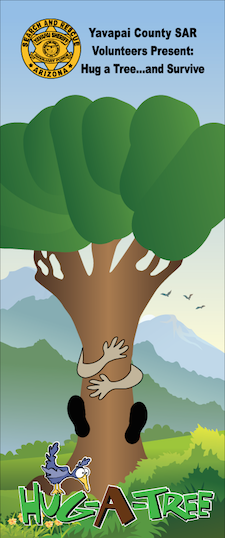2 Search and Rescues provide understanding that Hiking alone always increases Risk – A Cell phone was a lifeline in both cases
On July 18, 2020, around 10:45 PM, YCSO was contacted about a missing 16-year-old autistic male who had separated from his hiking companion and had not been seen since 7:30 PM. The missing teen was expected to return to a trail head in the Groom Creek area, but never showed. Deputies learned the teen had a phone, some water, food, and was wearing a head lamp. Initial attempts to reach him by phone were unsuccessful. As search and rescue teams were being called out, YCSO dispatchers were able to gain GPS coordinates from the teen’s cell phone service provider. Eventually, the teen was contacted by phone and told dispatchers his legs were hurting, he was lost and had turned his headlamp on. He was advised not to move further and let rescuers find him. Volunteers from the Yavapai County Jeep Posse and Yavapai County Search and Rescue Team Back Country Unit began assembling. Meanwhile, YCSO deputies were already well into the target area after hiking from different directions in complete darkness, including a 6-mile cross country stretch for one team, before they located the teen around 1 AM. Volunteers from the Back Country unit met with the deputies to aid in getting the teen back to the trailhead and his family just before 3 AM.
On July 19, 2020, at approximately 9:15 AM, YCSO received a call from the girlfriend of a 40year-old man who was hiking on the Red Rock Loop and called her to report he was overheated and thirsty. The subject had been dropped off on July 17, 2020 and been hiking since then. Deputies eventually reached the subject by phone and he refused to remain stationary because he was trying to locate water he previously hid in the wilderness. YCSO dispatchers were able to obtain GPS coordinates from his cell phone as search teams were being assembled. The subject told deputies he did not need help at this point. By 10:30, the subject called and indicated he was now stuck on the mountain, throwing up, had difficulty moving, and exhibiting hot and cold sweats. As a result, he was trying to get to shade and eventually found a small cave where he could rest.
Deputies, along with volunteers from the Verde Search and Rescue Team, and Sedona fire personnel deployed in such a way to ‘sandwich’ the hiker in to an area in case he decided to move again.
Just before 1 PM, a medic from the Department of Public Safety was airlifted to the subject’s vicinity and eventually located the subject. He was airlifted out, transported to a ground ambulance and taken to the Verde Valley Medical Center. Currently, his condition is unknown.
There is always an increased risk to your personal safety when hiking alone.
The availability of a cell phone in each case was a true lifeline for either subject - especially because they were hiking alone. Also, it is critical to stay stationary during a search operation and allow rescue teams to come to you. Constant movement requires ongoing tracking by rescuers which could delay a rescue and risks further danger to the hiker avoided by remaining stationary. AND, be thankful for our dedicated deputies and search and rescue volunteers willing to come find you 24/7 without hesitation.
See below for more critical hiking tips from the US Forest Service-
Hiking Tips - https://www.fs.usda.gov/visit/know-before-you-go/hiking
Hiking is a wonderful way to see and experience the many wonders of our nation’s forests. Visit your forest’s ranger district office, our All Maps page, or National Forest Store to obtain a trail map to help you plan your route based on your ability, available time and interest. Please follow these safety tips to ensure a safe journey: A photo of a family walking through the forest
Stay on marked trails.
Don’t hike alone. Let the slowest person in your party set the pace. This is especially important when children are a part of your group.
Leave your itinerary with a friend or family member and check in with them upon your return.
Develop an emergency plan before you start your trip. Make sure everyone knows what to do if they become lost or a medical emergency arises. Give children whistles with the instructions to "stop and blow" if they become lost.
Take frequent rests or vary your pace to maintain your energy wrong.
Drink plenty of water, even on cool, wet days. Never drink your entire supply between refills. Wear appropriate clothing, including sturdy boots that are broken in and are comfortable.
Consider using a hiking pole or walking stick to help maintain your balance in unlevel or hazardous areas.
Be aware of your surroundings, and pre-plan your approach before hiking through more hazardous areas. Wet surfaces can be a hazard and even more so if it's on a slope.
Consider what you'll do if you start to slide or fall so that you are prepared.
If falling, do not try to catch yourself; try to avoid landing on your hands, elbows or knees. Landing on the side of your body is much safer.
If the slope is such where you know you are going to slide, lowering your center of gravity, by sitting down and sliding on your feet or bottom, is safer.
If sliding while standing up, keep your weight over your feet and bend your knees—do not lean back or forward while sliding.
If on a day hike, extra weight wears you down and reduces your agility over uneven terrain. Pack as light as possible. Leave the extras behind, but consider bringing these essentials:
Map
Sunglasses and a hat
Sunscreen
Flashlight
Waterproof matches
First aid kit
Water and water-purifying tablets
High-energy bars, granola, candy, or fruit
Extra clothing. Temperatures can change dramatically, particularly if there is an elevation change. For every 1,000 feet of elevation gain, the temperature often drops three to five degrees.
Source: U. S. Forest Service; National Park Service






































